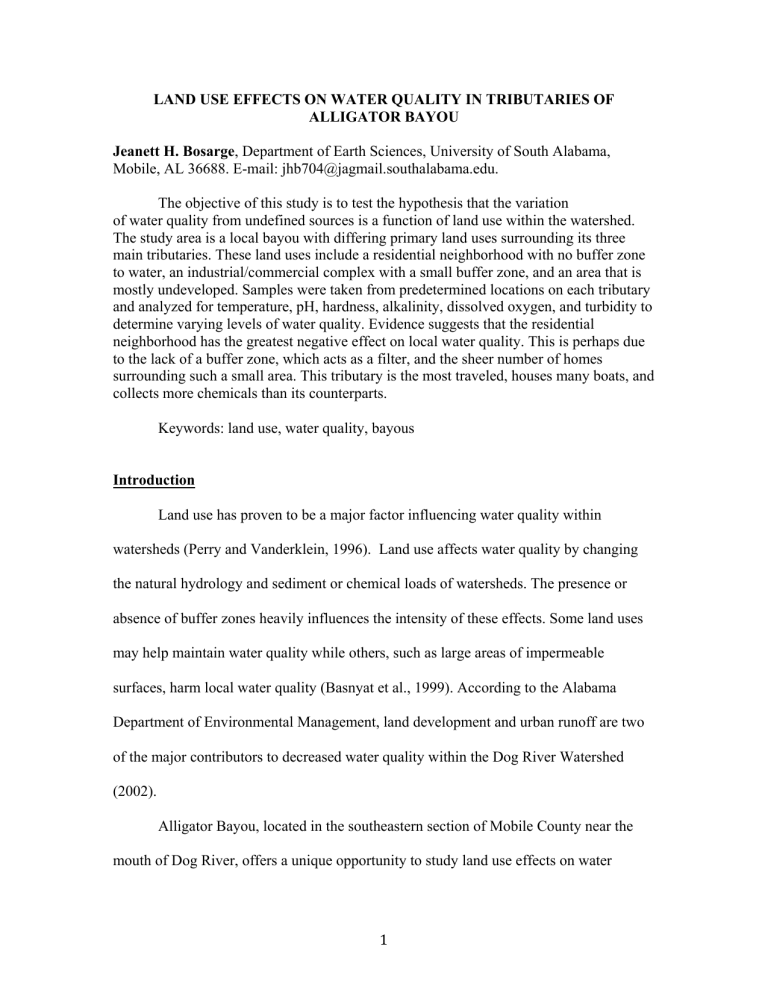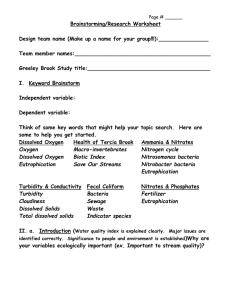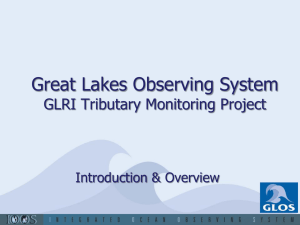Mobile, AL 36688. E-mail: .

LAND USE EFFECTS ON WATER QUALITY IN TRIBUTARIES OF
ALLIGATOR BAYOU
Jeanett H. Bosarge , Department of Earth Sciences, University of South Alabama,
Mobile, AL 36688. E-mail: jhb704@jagmail.southalabama.edu.
The objective of this study is to test the hypothesis that the variation of water quality from undefined sources is a function of land use within the watershed.
The study area is a local bayou with differing primary land uses surrounding its three main tributaries. These land uses include a residential neighborhood with no buffer zone to water, an industrial/commercial complex with a small buffer zone, and an area that is mostly undeveloped. Samples were taken from predetermined locations on each tributary and analyzed for temperature, pH, hardness, alkalinity, dissolved oxygen, and turbidity to determine varying levels of water quality. Evidence suggests that the residential neighborhood has the greatest negative effect on local water quality. This is perhaps due to the lack of a buffer zone, which acts as a filter, and the sheer number of homes surrounding such a small area. This tributary is the most traveled, houses many boats, and collects more chemicals than its counterparts.
Keywords: land use, water quality, bayous
Introduction
Land use has proven to be a major factor influencing water quality within watersheds (Perry and Vanderklein, 1996). Land use affects water quality by changing the natural hydrology and sediment or chemical loads of watersheds. The presence or absence of buffer zones heavily influences the intensity of these effects. Some land uses may help maintain water quality while others, such as large areas of impermeable surfaces, harm local water quality (Basnyat et al., 1999). According to the Alabama
Department of Environmental Management, land development and urban runoff are two of the major contributors to decreased water quality within the Dog River Watershed
(2002).
Alligator Bayou, located in the southeastern section of Mobile County near the mouth of Dog River, offers a unique opportunity to study land use effects on water
1
quality. Using Google Earth imagery, the three largest tributaries feeding into Alligator
Bayou were selected (2013). Combined with the use of the City of Mobile zoning maps, surrounding land use for each tributary was determined (2007). . In this case, the tributaries of Alligator Bayou are each dominated by a different land use, including mostly undeveloped land (sub-shed 1), a residential neighborhood with no buffer zone
(sub-shed 2), and light industry or commercial areas with a small buffer zone (sub-shed
3). Figure 1 below displays this information visually.
Fig. 1: Hand-drawn land use map of study area. White lines delineate subwatersheds.
2
Because of these qualities, the sub watersheds of Alligator Bayou provide a unique control area for testing land use impact. This research should provide useful information to the Dog River Watershed community by raising awareness, and potentially inspiring additional studies that are more comprehensive. Additional water quality records from this study will now be available as well.
There is only one former testing site on Alligator Bayou, with no current sites being monitored. According to Alabama Water Watch (AWW), the former site
(#06005016) was last tested in 2008 leaving a large absence of historical data. This site was located close to Dog River on Alligator Bayou, rendering the historical data useless for the purposes of this research.
Research Question
How will surrounding land use affect water quality in a small, sub-watershed?
Which land use will have the greatest impact?
Methods
A topographic map with a contour interval of two feet was used to delineate the sub-watersheds of Alligator Bayou. Meanwhile, aerial photography was used to manually create a land use map. These two elements were combined in order to form a comprehensive map of the study area, and to determine the best locations for testing along each tributary.
Sample collection and testing followed the standard water testing protocols using a LaMotte Water Monitoring Kit. The tributaries were each tested four times through the
3
month of March 2015 for air and water temperatures, dissolved oxygen, alkalinity, hardness, pH, and turbidity. Each test site was sampled in the same manner and order every week. Additionally, the time sampled was approximately the same for each tributary on each test day to further ensure trend accuracy.
A thermometer was set up to determine air temperature upon arrival of each site.
Actual sampling began by collecting and fixing dissolved oxygen samples. While the precipitates settled in the dissolved oxygen samples, pH levels were tested. After testing pH, the precipitates had settled enough to add the sulfuric acid and finish fixing the samples. Once these samples were fixed, the air temperature was recorded and the thermometer transferred into the water to determine water temperature. Hardness and alkalinity levels were then tested and recorded as well. The paddleboard was not steady enough on the water to obtain an accurate turbidity reading. Turbidity samples were collected in empty water bottles and tested on land. The pictures in figure 3 below show turbidity testing at two of the three sites. Testing at each tributary ended by completing dissolved oxygen tests and recording water temperature.
Fig. 2: Pictures by Evan Bennett. Photos show turbidity sample collection/testing.
4
The data from these samples were entered into Microsoft Excel and used to create charts displaying results. National Oceanic and Atmospheric Administration (NOAA) was used to determine tidal and rain data. Tidal and rain data helped to analyze trends and possible causes for variations in levels for each parameter.
Results and Discussion
Dissolved oxygen levels were consistently highest at the undeveloped site. The only exception to this was the third day of testing when the residential site slightly exceeded the undeveloped site. Figure 3 below displays the relationship between dissolved oxygen and water temperature at each of the test sites.
Fig. 3: Relationship between water temperature and dissolved oxygen
Dissolved oxygen is inversely related to water temperature; lower water temperatures are able to hold more dissolved gases than higher water temperatures. Both the levels of
5
dissolved oxygen and saturation percentages showed a similar temporal trend over the month. However, many other variables can affect levels of dissolved oxygen as well.
According to NOAA, salinity is an influencing factor for dissolved oxygen levels within an estuary; as salinity increases the ability to hold dissolved gases decreases (2008). On the third test day, many boats were observed in the residential area. According to my field notes, there were at least 4 motorized watercrafts near my test sites just before sampling. The turbulence created from these boats likely increased the levels of dissolved oxygen. However, on the same day, March 22, there was also a high tide, which pushed in salt water. This too helped influence diminished levels of dissolved oxygen at the undeveloped site, which sits the closest to the mouth of the bayou and is most vulnerable to salinity variations.
Levels of pH were unique to each site, but were within expected values. The industrial/commercial site always tested slightly more acidic than undeveloped, which generally recorded as 6.5. The residential area tested as slightly more basic, with values between 7 and 7.5. This should be expected with the varying land uses, as residential areas tend to release more basic chemicals, such as lime and soaps. These types of chemicals are introduced into the waterways when homeowners fertilize their lawns; use a septic tank system; or concrete or rock driveways and neighborhood roads (EPA 2012).
The alkalinity and hardness levels, like the pH findings, show little variation temporally, except for the undeveloped site on the last two days of testing. Figure 4 below displays alkalinity and hardness levels in relation to tidal fluctuation, which was briefly discussed previously. The high tide that occurred on the third day of testing brought salt water farther into the undeveloped tributary. This is the most likely cause of
6
the sharp spike in hardness. There is no significant change in alkalinity to suggest the addition of other chemicals (EPA 2012).
Fig. 4: Hardness and alkalinity in relation to tide.
NOAA’s tide gauge located at the Dog River Bridge (#8735391) was used to gather tidal information. This can explain the excessive levels of hardness on March 22 and March 29. However, amphidromic effects and wind data should have been considered also, as they have some effect on tidal fluctuations as well. Another possibility is that because of the relatively small size of the undeveloped watershed, there was not enough freshwater coming in to push the salt water completely out as the tide dropped on March 29, the fourth test day (NOAA 2008).
Turbidity was consistent at both the residential and undeveloped sites, remaining at 20 JTUs and 15 JTUs on 3 of 4 days, respectively. The industrial/commercial site showed the highest and most variable levels of turbidity throughout the study, ranging from 25 JTUs to 35 JTUs. The undeveloped site produced the lowest turbidity records consistently. This also may have to do with the relatively small sizes of the residential and undeveloped sub-sheds in relation to the rather large size of the
7
industrial/commercial sub-shed (NOAA 2008). The industrial site drains a larger amount of land that has more impermeable surface area.
Conclusion
The residential area seems to have the greatest impact on water quality. The overall density of the homes, and the lack of a buffer zone are likely the biggest culprits for the extent of impact. Also, most of the industrial/commercial area lies within city limits, while the residential area in its entirety lies outside of city limits in the county. As a result, the industrial/commercial areas are subject to much more comprehensive rules regarding environmental regulations. Overall, the data shows the undeveloped area to be the least affected, and the residential area to be the most affected, which seems to be a function of the surrounding land use associated with each sub-shed.
Overall, this study was an excellent opportunity to gain hands-on experience, and there are many things I now know to approach differently for future purposes. GIS software and data would be used to map land uses and impermeable surfaces in the study area, as I’m not fond of the hand-drawn version. Data was the biggest obstacle for this task. Many other variables need to be monitored including tide, wind, and rainfall regularly. Another weakness of this study lies in the amount of time it covers. Samples were only taken four times over one month. Several months of data gathered multiple times per week would be ideal for future studies.
8
References Cited
Alabama Department of Environmental Management. 2002. Final 2002 303(d) List and
Fact Sheet.
Alabama Water Watch. 2008. Alabama Water Watch Water Chemistry Monitoring.
“Alligator Bayou.” 30°33'28.69” N and 88°06'51.56" W. Google Earth. November 2013.
February 2015.
Asplund, Timothy. (2000). The Effects of Motorized Watercraft on Aquatic Ecosystems .
Madison, WI: Wisconsin Dept. of Natural Resources.
Basnyat, P., Flynn, K., Lockaby, B., & Teeter, L. (1999). Relationships Between
Landscape Characteristics and Nonpoint Source Pollution Inputs to Coastal
Estuaries. Environmental Management, 539-549.
City of Mobile. 2007. City of Mobile Zoning Map.
Environmental Protection Agency. (2012). Sources, Stressors & Responses. Retrieved
May 2015, from http://www.epa.gov/caddis/ssr_home.html
Environmental Protection Agency. (2012). Stressor Identification. Retrieved April 2015, from http://www.epa.gov/caddis/si_home.html
NOAA. (2008). Salinity. Retrieved May 2015, from http://oceanservice.noaa.gov/education/kits/estuaries/media/supp_estuar10c_salini ty.html
Perry, J., & Vanderklein, E. (1996). Water quality: Management of a Natural Resource .
Cambridge, Mass., USA: Blackwell science.
9





